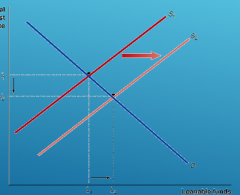![]()
![]()
![]()
Use LEFT and RIGHT arrow keys to navigate between flashcards;
Use UP and DOWN arrow keys to flip the card;
H to show hint;
A reads text to speech;
19 Cards in this Set
- Front
- Back
|
An upward trend of real GDP over time. Sometimes, economists use real GDP per capita instead of real GDP because it is a better measure of standards of living in a given country. |
Long-run economic growth |
|
|
What does the level of GDP per capita tells us about the living standards in a given country? |
The higher the GDP per capita, the more goods and services people can afford to buy, and the higher their utility is - Higher GDP per capita also means better healthcare and better health. - Growing GDP per capita results in a decreasing hours of work and increasing leisure time. |
|
|
Generally, thought to be determined by the available supply of productive resources, namely, labor, capital, and technology. |
Economic growth is called potential GDP (Y*): |
|
|
Increases in GDP per capita depends to a great extent on increases |
labor productivity. |
|
|
The quantity of goods and services that can be produced by one worker or by one hour of work. |
Labor productivity |
|
|
Labor productivity is determined by two key factors: |
(1) The quantity of capital per hour worked. (2) The level of technology |
|
|
manufactured goods that are used to produce other goods and services |
Capital |
|
|
acquisition of capital by firms. |
Investment |
|
|
an increase in the quantity of output firms can produce using a given quantity of inputs; is more important for economic growth than capital per hours worked. |
Technological Change |
|
|
the system of financial markets and financial intermediaries through which firms acquire funds from households to make investments: |
Financial System |
|
|
Markets where financial securities, such as stocks and bonds, are bought and sold. |
Financial markets |
|
|
are firms, such as banks, mutual funds, pension funds, and insurance companies, that borrow funds from savers and lend them to borrowers. Households’ savings are transformed into firms’ investments. |
Financial intermediaries |
|
|
Total investment should equal |
Total Saving |
|
|
The interaction of borrowers and lenders that determines the market interest rate and the quantity of loanable funds exchanged |
Market for loanable funds |
|
|
Two main sources of supply of loanable funds: |
1) households (private saving) 2) government (public saving) |
|
|
Three main sources of demand for loanable funds: |
1) households (private loans) 2) government (issues government bonds) 3) corporations (issue bonds and stocks) |
|
|
Application 1 of Loanable Funds: Technological Change |

|
|
|
Application 2 of Loanable Funds: Increase in the Budget Deficit |

|
|
|
Application 3 of loanable funds: Consumption Tax Instead of Income Tax? |

|

